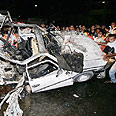
Assassination aftermath in Gaza
צילום: איי אף פי
Sowing fear in Gaza
Air Force ensures that as long as rocket attacks persist, Gaza residents won't be sleeping at night
The name of the game is fear.
The fear of shattered glass emptied top floors, while high-rise offices were closed down. Gaza’s frightened residents have already learned that it’s safer on the ground.
The Islamic university in Khan Younis also closed down after deep cracks were found in its walls. Meanwhile, Khan Younis’ governor is despaired: In the past week, he replaced the windows in his office twice.
The fear permeates every corner, from the kindergartens to government institutions. Those who promised that if the children in the southern Israeli town of Sderot won’t be able to sleep at night, the same would be true for Gaza’s children, got their wish.
Since the beginning of the week, every two hours almost, during daylight, the airplanes appear. Each time, an F-16 flies through the Gaza sky, leaving behind it a sonic boom, destruction, and anxiety.
Every night, in order to disturb the residents’ sleep, the airplanes appear twice. The sonic booms have turned into the nightmare of Strip residents. They are waiting for them, know they are coming, and are having difficulties adjusting.
For the Air Force, those sonic booms are a true operation. The Strip is short after all, it takes seconds to fly over it, and the boom must appear in the right place. So they calculated the jets’ entry points with millisecond precision. They also checked different altitudes. Every time the planes fly a little lower, to enhance the effect.
In order to deepen the anxiety, every night there are power outages at different neighborhoods in the Strip. Israeli officials have denied any connection to them.
Intelligence and fire
On Tuesday, when Defense Minister Shaul Mofaz arrived for a tour of the Gaza Division, the commanders told him that the Palestinians are infuriated with the collective punishment employed by Israel. The Palestinians say they cannot recall such aerial assault since 1967.
However, Mofaz rejected out of the hand the possibility of easing the pressure. On the contrary, he wouldn’t mind seeing more pressure. The way he sees it, we haven’t yet reached the peak.
The fear in Gaza is accompanied by uncertainty. The assassination of Islamic Jihad leader Sheikh Khalil, and Mofaz’s declaration that Hamas leaders are legitimate targets for assassination, thinned traffic on Gaza’s streets. Those who don’t have to, choose to stay home.
After all, one doesn’t know where the next missile will come from and who it will be targeting.
In one of the discussions that took place this week at the defense minister’s office, one of the IDF officers remarked: “The Hamas has already been brought to its knees.” Another senior officer responded: “I don’t want them just down on their knees. I want the skin on their knees to be completely scraped.”
In recent days, farmers in Beit Hanoun began counting the artillery shells that land in their fields. Here too, just like with the sonic booms, it has become a ritual. Every 12 hours, the artillery battery fires at the partition between residential Palestinian areas and the Israeli border. In principle, it’s an agriculture area, but Mofaz’s orders make it clear: As long as Qassam rockets are fired from there, nobody will be walking around there.
The Air Force has destroyed the bridges and roads leading to those areas, and once, after a Qassam barrage, 20 shells landed in the fields and shook the entire area.
However, the artillery is merely dessert. The “big show” belongs to the Air Force, and all types of aircraft are taking part in it: Transport planes, fighter jets, gunships, and unmanned aircraft. For the Air Force, the Strip has turned into a test ground for combat doctrines dealing with aerial control over urban areas.
During operation “First Rain,” hundreds of sorties have been flown over Gaza. Different kinds of aircraft are performing different missions, ranging from intelligence tasks to strikes. The aircraft maintain a continuous presence over the area, and while doing so are also “conversing,” relaying information, double-check intelligence, and prepare for strikes within seconds of identifying the targets.
Then there is a whole range of smart bombs, starting from the small one-kilogram (2.2 pounds) and up to the ones weighing a ton. Meanwhile, a large number of the Qassams fired at Israeli targets were photographed by special intelligence systems. The weapon systems required to destroy the Qassams were not always available, but the Air Force is learning, and improving.
The objective is, at the end of the day, to create an “effective ceiling of intelligence and fire” above the Gaza Strip












